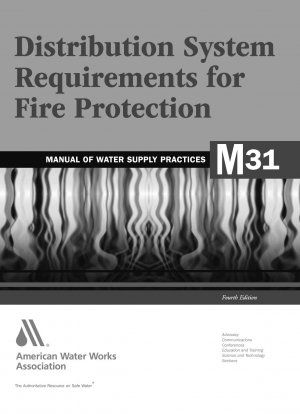AWWA M31-2008
Distribution System Requirements for Fire Protection Fourth Edition
- Standard No.
- AWWA M31-2008
- Release Date
- 2008
- Published By
- American Water Works Association (AWWA)
- Latest
- AWWA M31-2008
- Scope
- Water distribution systems have been developed and operated for a variety of reasons. In the past, many communities recognized the need for safe, potable water that could be used for drinking and cooking. Governmental agencies or private enterprise promptly took on the responsibility of providing safe water to meet these basic human requirements. The need for nonpotable water arose because of an increasingly sophisticated lifestyle. In many cases, the water systems established to provide potable water were augmented and enlarged to provide water for irrigation, car washing, industrial processes, and other purposes. It also became necessary to provide an adequate supply of water for fire protection and suppression. Systems that provide for fire protection needs have frequently been incorporated into the systems that provide potable water service as well as nonpotable service. As technology advances, many alternatives to this basic water supply configuration can be found. A notable alternative is the use of dual distribution systems. The American Water Works Association has published standards for materials used in the field of fire protection for many decades. However, it was not until the early 1980s that AWWA’s Committee on Fire Protection developed the first edition of this manual, which addresses the planning, design, and maintenance of distribution systems that supply water for fire protection and suppression. This manual provides specific guidance on the design, operation, and maintenance of water distribution systems as they relate to fire protection and fire suppression activities. When the governing body of a community makes a conscious decision to use the available water supply system for fire suppression purposes, this manual should be consulted, judiciously applied, and tempered as local conditions require. This edition of the manual updates the information, clarifies some topics, and deletes material that is no longer essential. The manual still closely parallels the first edition prepared by the Fire Protection Committee. As was the case with the first edition, this fourth edition does not intend to describe how firefighters should use water to control fires, but rather how water utilities should design and operate their systems to maximize fire protection benefits while delivering safe, potable water to customers. The emphasis is on public water systems and not on water systems exclusively designed for fire protection. Similarly, this manual does not intend to reproduce material available elsewhere in AWWA publications such as Manual M17, Installation, Field Testing, and Maintenance of Fire Hydrants, or Standards C502, Dry-Barrel Fire Hydrants, and C503, Wet-Barrel Fire Hydrants. The adequacy of a water distribution system for fire protection depends on the fire flows required. Chapter 1 describes several methods for determining required fire flows. Once fire flow requirements are determined, these are added to the other water system demand requirements. Chapter 2 discusses the impact of fire protection on distribution system design. Chapter 3 focuses on distribution storage in terms of both sizing and location. Chapter 4 discusses reliability issues arising because systems must remain in operation even when individual components are out of service. Chapter 5 describes fire suppression sprinkler systems and their effect on water requirements, particularly because they affect how water is used for fire fighting.
AWWA M31-2008 history
- 2008 AWWA M31-2008 Distribution System Requirements for Fire Protection Fourth Edition
- 1998 AWWA M31-1998 Distribution System Requirements for Fire Protection Third Edition
